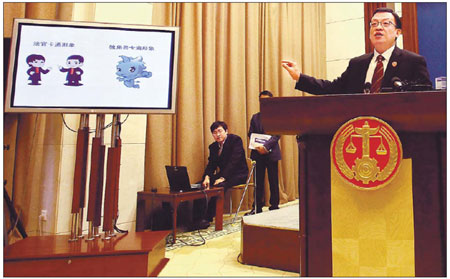Society
Top court reveals life behind bench
By Zhang Yan (China Daily)
Updated: 2010-12-04 09:41
 |
Large Medium Small |
 |
|
Sun Jungong, spokesman of the Supreme People's Court, introduces cartoon images of male and female judges (left on screen), and Xiezhi, a legendary Chinese creature representing justice, in Beijing on Dec 3, 2010, as the court opened to the public. [Photo by Xu Yang / China Daily] |
BEIJING - The country's top court took off its mysterious mask on Friday by opening its trial halls to the public for the first time.
The Supreme People's Court also released cartoon images representing the judicial system to solicit public opinion.
The event, designed to increase the transparency of the court system, came ahead of the country's 10th Legal Publicity Day, which falls on Saturday.
| ||||
Yu Xiaobai, a chief judge who handled the case, told China Daily that since 2008 the number of intellectual property disputes that courts across the country have handled has increased by an average of 50 percent each year.
"That's why we've chosen such a case for the public open day," she said.
"By attending the hearing, the public will have a better understanding of our work in case, trial and judgment, and this will enhance the transparency of the court and narrow the distance between us and the public," Yu said.
Apart from the court hearing, the public representatives also visited the court's museum, where about 1,500 precious historical documents and photographs were on display to reveal the country's judicial history. The guests also watched a documentary on a day in the working life of three Chinese grassroots judges.
Sun Jungong, the top court's spokesman, said in many people's eyes the Supreme People's Court is mysterious, and sometimes members of the public even doubt the fairness of the court's rulings and sentencing.
"The openness is an effective way to communicate with the public, and to allow them to have more direct experience of our life and work, " he said.
The top court on Friday also released two cartoon images to solicit public opinion. The public can view them on the court's official website and submit their opinions by Jan 16, 2011.
One cartoon that depicts two judges, a man and a woman, was based on photos of real judges. It will be used on relatively formal occasions, such as in the registration and petition halls.
The other is based on Xiezhi, an animal in Chinese mythology credited with the ability to distinguish between right and wrong. That cartoon will be used on casual occasions to represent the rule of law, according to the top court.
"Rather than the normal solemn and stern faces of the judges, the cartoon images are lively and cute," Sun said.
"Such images can be easily accepted by the public and bring some attractive elements to legal publications. Once people feel the law and social rules are not so remote, they might accept and follow the law more readily," he said.
Sun also promised that the top court will continue to open up to the public.
Du Yanmei, a representative from Beijing's Zhengyilu community who attended the opening day on Friday, said she enjoyed the visit.
"I hope the top court and local courts can regularly hold such open activities, so that the public, especially young people, can learn about how judges work and about the country's legal system," she said.



